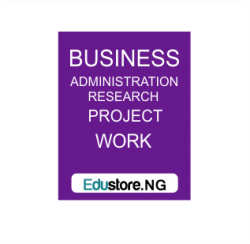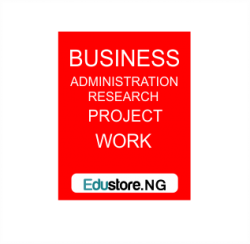CHAPTER ONE
INTRODUCTION
1.1 BACKGROUND OF THE STUDY
Manpower occupies an indispensable position in every establishment, be it manufacturing or service organizations, like Dangote Sugar Refinery PLC. This means that without manpower no establishment can function. In essence, human effort is greatly desirable and fundamental in achieving the goals and objectives of the organization. The onuses as to how an organization thrives are at their whims and caprices; the supply of labour, technical and professional skills, which are apropos for effective and efficient planning and implementation of development policies, programmes, projects and daily functioning of the organization are their prerogative, it cannot be succinctly stated that manpower constitute organizations’ greatest asset.
Thus, the pivotal role of manpower in an organization, informed the importance that its development cannot be optional but something that must be done irrespective of the personnel previous training or experience. Manpower development is an indispensable component of strategic human resource management as well as a means of reducing inefficiency among organizational key asset- its human resources, and it is vital for workers’ productivity and organizational performance. Since the formal educational system does adequately provide specific job skills for a position in a particular organization, while few employees may have the required skills, knowledge, ability and competencies needed to fit into a specific job position in an organization. Thus, it is through manpower development process that employees are trained and developed to fit into organizational strategic goals and objectives. It is germane to espouse the position of Druker (2000), who opined that manpower development is seen as a concept which is generic because it focuses on training out human resources that is needed for the development of an organization.
Manpower planning and development as a function of management is highly indispensable in the achievement of organizational objectives. There is need to plan for the various resources such as human, material and time, etc, in order to achieve stated objectives. It should be noted that it is the function of the personnel to combine the various resources in an appropriate manner in order to actualize the objectives of the organization. In this globalized era, there are increasing claims that the route to competitive advantage is achieved through people. In a situation where identical non people resources in the form of finance, raw materials, plants, technology, hardware and software are made available to competing organizations, the differences in economic performance between organizations can be attributed to differences in the performance of the organizations workforce. In other words, the calibre of the human resources in an organization determine the success or failure of an organization, hence, justify the rationale to plan for, and develop the personnel in various units of the organization in order to achieve the stated goals.
According to Ake (2001), the development of indigenous manpower to serve as the propelling force for national growth and development is no doubt a key to Nigeria’s socio-economic and political development. This is quite indispensable considering the argument of the concept of transfer of technology as a propelling force for the development of the developing countries of which Nigeria is one (Ake 2001). However, it is important to state that the lack of adequate emphasis on manpower planning and development as a tool for development in Nigeria on the part of government as well as the organized private sector could not be far-fetched from the lack of understanding of both the concept and methods for manpower planning and development in a postcolonial
Nigerian State in which the process of manpower planning and development for national growth was distorted by colonialism with it attendant negative orientation that was injected into political leadership (Ekpo 2009). Thus, manpower planning and development became an elitist design that was geared to favour capitalist mode of production in which labour was relegated to the background among the factors of production (Omodia, 2009:113).
Organizational effectiveness rests on the efficient and effective performance of workforce that makeup the organization. The efficient and effective performance of the workforce in turn, rest on the richness of the knowledge, skills and abilities possessed by the workforce. Capacity building and development in most organizations is a continuous act/exercise. The inexorable march of time and the ceaseless glamour for social change combine to make adaptability and continuing preparation of the workforce as inevitable as the initial acquisition of knowledge and skills. This cannot happen if employees‟ capacity building and development do not occur in an enterprise. In other to maximize the productivity and efficiency of the organization, every executive, manager or supervisor in a public or private organization has the responsibility and indeed the bounding duty to ensure the development of their employees who have requisite knowledge and expertise (Dada, 2004).
1.2 STATEMENT OF THE PROBLEM
The challenge of human capital development for developing nations is daunting. This is in consideration of how far ahead the rest of the world is and the enormous efforts and resources required of them to catch up. Nigeria’s high population, vast socio-cultural diversity, yet-to-mature political culture and the great hope repose on her to emancipate the black-race, makes the challenge even more critical for us. The good news however, is that there is cause for great optimism because the nation has more than enough human capital potentials to surmount the challenge if harnessed, activated and effectively channeled.
For this reason, it encounters numerous problems which range from:
1) Lack of qualified instructors and consultants to undertake capacity building courses,
2) Lack of essential capacity building tools, to
3) Lack of effective communication within the organization which makes it impossible for most employees to know about capacity building opportunities available to them.
1.3 OBJECTIVES OF THE STUDY
The general objectives of this study is to examine the Impact of effective manpower on the development of organizations, a case study of Dangote Sugar Refinery PLC. The specific objectives include:
1. To ascertain the quality of manpower in Dangote Sugar Refinery PLC.
2. To find out if there are manpower training and development in Dangote Sugar Refinery PLC.
3. To examine the effects of manpower training on the productivity of Dangote Sugar Refinery PLC.
4. To investigate if Dangote Sugar Refinery PLC gives incentives to their employee in order to motivate them.
1.4 RESEARCH QUESTIONS
The relevant research questions related to this study include the following:
1. What is the quality of manpower in Dangote Sugar Refinery PLC?
2. Are there manpower training and development in Dangote Sugar Refinery PLC?
3. What are the effects of manpower training on the productivity of Dangote Sugar Refinery PLC?
4. Does Dangote Sugar Refinery PLC give incentives to their employee in order to motivate them?
DOWNLOAD COMPLETE WORK- For Reference Only: Materials are for research, citation, and idea generation purposes and not for submission as your original final year project work.
- Avoid Plagiarism: Do not copy or submit this content as your own project. Doing so may result in academic consequences.
- Use as a Framework: This complete project research material should guide the development of your own final year project work.
- Academic Access: This platform is designed to reduce the stress of visiting school libraries by providing easy access to research materials.
- Institutional Support: Tertiary institutions encourage the review of previous academic works such as journals and theses.
- Open Education: The site is maintained through paid subscriptions to continue offering open access educational resources.






